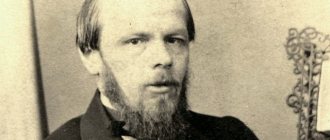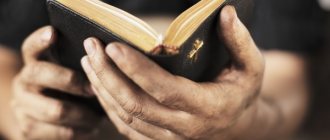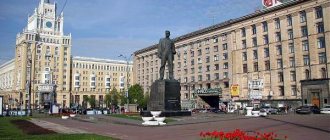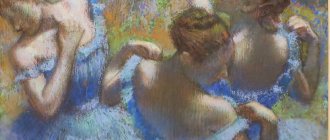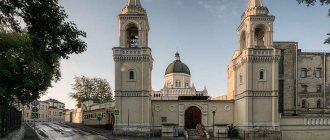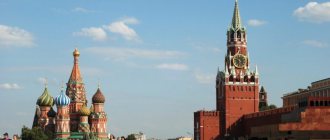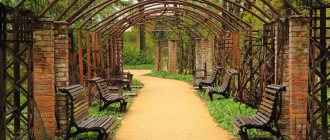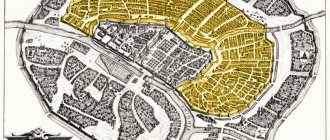Pushkin is rightfully considered one of his people in St. Petersburg - his youth, spent at the Tsarskoye Selo Lyceum, collaboration with local literary magazines, the creation of key works, and finally, the last duel on the Black River are connected with the city on the Neva. But he was born, grew up, began writing poetry, and later met the main love of his life, Natalya Goncharova, married her and spent the first months of his married life here, in Moscow.
In honor of Pushkin’s birthday, we invite you to tune into a lyrical mood and walk through the places where the most interesting events of his life unfolded.
The main mystery: place of birth
The intersection of Malaya Pochtovaya Street and Hospital Lane
Let's start from the very beginning - from the place where, on June 6, 1799, a boy was born who would be destined to revolutionize the ideas of his contemporaries about versification and easily, as if by playing, lay the foundations of the modern Russian literary language. The address of the house where Pushkin was born has long been a mystery to his biographers. The poet himself treated this issue somewhat frivolously - for example, he claimed that he was born on Molchanovka. This cannot be true: he left Moscow for Tsarskoe Selo from his house on Bolshaya Molchanovka at the age of 12, but it is known that the Pushkin family moved a lot and from the moment Alexander was born until his 12th birthday, they managed to change at least 10 addresses.
In 1879, the biography of Alexander Sergeevich was published in the magazine “Russian Antiquity”. It contained an extract from the archives of the church where he was baptized. According to the certificate, he was born in the house of the college registrar Ivan Skvortsov. Then the address of the house was mistakenly identified as Nemetskaya Street (now Baumanskaya), 57. A memorial plaque was placed on the house. Later, the mistake was corrected by Soviet Pushkin scholars - in 1927 the plaque was moved to the school building located at 40 Baumanskaya Street. School No. 353 still bears the name of the poet, but Pushkin was not born here. To visit the site of the house where the Pushkins lived in 1799, go to the intersection of Malaya Pochtovaya Street and Hospital Lane. The house of the collegiate registrar Skvortsov, of course, did not survive - it burned down in a fire in 1812.
Povarskaya street, 27
Photo: wikimedia.org/Moreorless
In 1828, Pushkin enthusiastically worked on the poem “Poltava”. According to the poet’s contemporaries, he plunged headlong into the study of Ukrainian folk songs, the personality of Hetman Ivan Mazepa and the Battle of Poltava.
Words of a contemporary
In the winter of 1828, Pushkin wrote “Poltava” and, full of its poetic images and harmonious verses, often came into my room, repeating the last verse he wrote; So he entered once, loudly saying: “The battle has struck, the Poltava battle!” Anna Kern
(1800–1879) Noblewoman, memoirist
The poem was ready by the end of the year. The first reading took place in a modest circle of friends - there were only four listeners: the owner of the apartment, retired colonel Sergei Kiselev, Pyotr Vyazemsky, Count Fyodor Tolstoy and the son of General Bashilov Alexander, whom Pushkin “encouraged in the field of literature.”
The house in which Pushkin first read his Poltava can still be seen today. It is located at Povarskaya Street, 27. In the modern history of Moscow, poetry has hardly been heard here - until 2010, the building was occupied by the Russian-German Bank (now liquidated), today it is shared by a charter airline and a real estate agency.
The most honest rules: the house of the poet's uncle
Staraya Basmannaya street, building 36
It is believed that it was Vasily Lvovich Pushkin who taught little Alexander Sergeevich to write poetry. Whether it was true or not is now quite difficult to establish. But there is no doubt that the uncle influenced his nephew’s views on modern literature. It was he who helped ensure that young Alexander was admitted to the prestigious Tsarskoye Selo Lyceum, where his talent was noticed by “old man Derzhavin.”
Back in his lyceum days (the training lasted six years), Alexander Pushkin was accepted into the Arzamas society, which opposed archaism and pomposity in modern literature. My uncle and nephew were both members of Arzamas - Vasily Lvovich was one of its most senior members.
His uncle's house on Staraya Basmannaya was one of the poet's favorite places. It was here that he made his first visit, returning to Moscow after Mikhailovsky exile in 1826.
On June 6, 2013, a house museum opened in the mansion of Vasily Pushkin. It recreates the interiors of the entrance hall, hall, dining room, office and the “Dangerous Neighbor” room, dedicated to the heated debate between “Arzamas” and the “Conversation of Lovers of the Russian Word” society, which advocated for the preservation of the ideals of classicism. “Dangerous Neighbor” is the title of a frivolous poem by Vasily Lvovich, parodying the classic genre of travel: its heroes travel not from St. Petersburg to Moscow, for example, but from Moscow to a certain brothel on the outskirts. Faced with horrific scenes of debauchery, the main character runs away from the courtesans and the dangerous neighbor who prompted him to go on a campaign. In the “Dangerous Neighbor” hall in the Vasily Pushkin House-Museum you can see portraits of members of “Arzamas” and “Conversations...” and editions of their works.
Volochin N.M.: Pushkin’s places in Moscow and the Moscow region From the author
From the authorS. Ya. Marshak has amazing lines about how houses, streets, squares and alleys retain the warmth of human touch and remember the distant past:
Everything that a person touches acquires something human. This house, which has served us for a century, almost knows how to use speech.
Probably, it is in this sense that we can talk about Pushkin’s Moscow. Modern Gorky Street is not at all like the old Tverskaya, Kirov Street is not like Myasnitskaya, Pushkinskaya Square is like Strastnaya, and yet in modern Moscow many houses, streets, and boulevards “remember” the poet.
Moscow was the birthplace of Pushkin. Here he spent his childhood, here he perceived the first, most vivid and vivid “impressions of life” - the noisy discord of squares and streets, the labyrinths of narrow alleys, the diverse, colorful people of Moscow on weekdays and holidays, “palaces, gardens, monasteries”, the ancient towers of the Kremlin ...
In Zakharov, near Moscow, where the Pushkins went for the summer, the boy found himself at the mercy of the enchanting beauty of dim Central Russian landscapes, there were long exciting walks, Pushkin’s first acquaintance with the poetic world of folk customs, traditions, legends took place...
In the summer of 1811, Pushkin left Moscow to enter the Tsarskoye Selo Lyceum and returned here only 15 years later. However, his connections with Moscow were not interrupted all this time. His first poem to appear in print, “To a Poet Friend,” was published in the Moscow magazine “Bulletin of Europe” in July 1814. In subsequent years, many of Pushkin's works were published in Moscow magazines and almanacs.
While in southern exile, Pushkin corresponded with his friend, the poet and critic P. A. Vyazemsky, who lived in Moscow, and in 1823 sent him the manuscript of “The Bakhchisarai Fountain” for publication. The poem was printed in the Moscow printing house of August Semyon, one of the best printing houses in Russia, and was published in March 1824. This was Pushkin's first book published in Moscow.
Pushkin's return to Moscow from Mikhailovsky exile in September 1826 was perceived by contemporaries as the most important event in the life of society. “Let us remember the first appearance of Pushkin, and we can be proud of such a memory... The reception from Moscow to Pushkin is one of the most remarkable pages of his biography,” wrote S. P. Shevyrev in 1841. “You should have seen the participation and attention of everyone when he appeared in society! When Pushkin was in the theater for the first time, the audience looked not at the stage, but at their favorite poet,” K. A. Polevoy later recalled.
In the first weeks spent in Moscow, Pushkin happily met with family, friends and acquaintances. Just a day after arriving in Moscow, on September 10, Pushkin read from his closest friend Sergei Aleksandrovich Sobolevsky the tragedy “Boris Godunov” written in Mikhailovsky. Following this, he read “Godunov” from P. A. Vyazemsky, E. A. Baratynsky, and the Venevitinovs; perhaps in the Europe Hotel, where the poet lived at that time and where his friends gathered. The tragedy made an unforgettable impression on the audience. According to Vyazemsky, Pushkin “in this creation ascended to a height that he had not yet reached.”
That same evening at Sobolevsky’s, the poet spoke about the need to create a new magazine and asked to introduce him to M. P. Pogodin, who, in his opinion, could become an editor, as well as those “with whom he could talk with pleasure.”
Soon Pushkin had many new acquaintances in Moscow, including the young Polish poet Adam Mickiewicz, M. P. Pogodin, who headed the Moskovsky Vestnik magazine since October 1826, the publisher of the Moscow Telegraph N. A. Polevoy, ethnographer and archaeologist I M. Snegirev, writers brothers I.V. and P.V. Kireevsky, V.P. Zubkov - friend of I.I. Pushchin. The poet often visited the salon of Princess Z. A. Volkonskaya, where Moscow writers, musicians, and actors gathered.
On November 1, 1826, Pushkin left for Mikhailovskoye. Returning to Moscow on December 19, he settled with S. A. Sobolevsky and lived with him for five months.
The literary life of Moscow was very lively at that time; Pogodin wrote about this almost 40 years later in the Russian Archive: “The hottest literary time has arrived in Moscow. Every day we heard about something new. Yazykov sent his inspired poems from Dorpat... Denis Davydov from the Caucasus; Baratynsky published his poems. Griboedov's "woe from mind" has just begun to spread. Pushkin read “The Prophet” (which after “Boris” had the greatest effect) and introduced us to the next chapters of “Onegin”, of which until then only the first chapter had been published... Lively and cheerful evenings followed one after another at the Elagins and Kireevskys behind the Red Gate , at the Venevitinovs, at me, at Sobolevsky...”
In the fall of 1826, the second chapter of “Eugene Onegin” was published in Moscow as a separate book, and in 1827 the poems “Gypsies” and “Robber Brothers” were published.
There is a lot of evidence about this period of Pushkin’s Moscow life - from the autumn of 1826 to the spring of 1827 - in correspondence, diaries and memoirs of contemporaries. N.V. Putyata, who met Pushkin through Baratynsky in September 1826, later wrote that Pushkin “easily got to know each other, became close, especially with young people, and visited different strata of society.” “He stood then,” Putyata asserted, “at the highest level of his popularity.” P. L. Yakovlev, the brother of Pushkin’s lyceum comrade, wrote from Moscow in March 1827 to his uncle A. E. Izmailov: “Judging by everything that I have heard and seen, Pushkin is in the roses here. The whole city knows him, everyone is interested in him, the most excellent young people gather to him, just as in ancient times everyone who had a little common sense in their heads gathered to the great Arouette (Voltaire - N.V.).
On May 19, 1827, Pushkin left for St. Petersburg; Having returned to Moscow on December 6 of the following year, 1828, he lived here for about a month. On this visit he met Natalya Goncharova.
Pushkin visited Moscow almost every year. Most often he visited P.V. Nashchokin, with whom he had a long-standing sincere friendship.
With each visit, the circle of the poet's Moscow acquaintances became wider. Among them were writers, scientists, actors, artists, and musicians. Pushkin visited Moscow theaters, the university, and worked in the Moscow archive of the Collegium of Foreign Affairs. He was interested not only in Moscow culture and science. He also knew well different aspects of Moscow life: he often attended folk festivals, the magnificent Hall of Columns of the Noble Assembly, and the English Club.
The diverse impressions of Moscow life were reflected in the seventh chapter of “Eugene Onegin”, in the draft versions of “Onegin’s Travels”, in the article “Journey from Moscow to St. Petersburg”. In this article, Pushkin notes significant changes in the social life of Moscow, in the everyday life of the townspeople, characteristic of the 30s.
In “pacified” Moscow, as Pushkin put it, everything spoke of decline, desolation, and impoverishment of the nobility: “... huge boyar houses stand sadly between a wide courtyard overgrown with grass and a garden, neglected and wild... On all the gates there is a notice that the house is for sale. and is rented out, and no one buys or hires it.”
At the same time, Pushkin notes significant progress in the economic and cultural development of the city. “...Moscow, which has lost its aristocratic luster, is thriving in other respects: industry, heavily patronized, has revived and developed with extraordinary strength... On the other hand, enlightenment loves the city where Shuvalov founded the university according to Lomonosov’s plans.”
The last time Pushkin came to Moscow was on May 3, 1836. The poet lived here for two and a half weeks; On May 20, he left his hometown forever.
The Pushkin Commission, created in June 1927 under the “Old Moscow” section of the Society for the Study of the Moscow Region, began to study Pushkin’s places in Moscow and the Moscow region. The commission included experts in Moscow - historians, archaeologists, architects. The result of their work was the collection “A. S. Pushkin in Moscow” edited by Professor M. A. Tsyavlovsky. In the articles by L. A. Vinogradov, N. P. Chulkov, N. P. Rozanov, placed in the collection, firstly, “finally and irrevocably” the place of Pushkin’s birth was determined and, secondly, a list of places “where Pushkin lived and visited Moscow,” compiled through a painstaking examination of a large number of registry books and “confessional statements,” old indexes and newspapers, and archival materials. The list of Pushkin’s places in Moscow was thus the result of a huge amount of work carried out by a whole team of highly respected scientists over several years.
Information about which places in Moscow and the Moscow region were associated with Pushkin’s stay is found in his letters, in the correspondence and diary entries of his contemporaries, and in memoir sources. In addition, it is customary to classify as Pushkin’s those places where he could have visited due to family, friendly, business or traditional ties. In some cases, it is only necessary to tentatively classify a particular house as a memorial one. Thus, it was not possible to establish where D.N. Sverbeev lived in 1836, when Pushkin visited him; the list indicates his address in 1839, since it is possible that Sverbeev lived in the same place three years earlier.
Of course, the list could not include all the places associated with the poet’s stay in Moscow: after all, no documentary evidence has been preserved about many of his visits to Moscow friends and acquaintances. For example, there are almost no addresses in Zamoskvorechye. Meanwhile, P. A. Vyazemsky recalled that there was “one winter or two” when he, G. A. Rimsky-Korsakov and Pushkin were “invited by acquaintances and strangers ... both to the German settlement and to Zamoskvorechye.” However, no matter how incomplete the traditional list of Pushkin’s places was, it certainly reflected the most important and significant connections between Pushkin and Moscow.
This list was somewhat expanded in the guidebook “Pushkin Moscow”, published in 1937, also edited by M. A. Tsyavlovsky (compiled by N. R. Levinson, P. N. Miller, N. P. Chulkov), and then with minor repeated with changes in the book by N. S. Ashukin “Moscow in the life and work of A. S. Pushkin” (M., 1949). A book by N.P. Verkhovskaya, published in 1962, is dedicated to Pushkin’s places in the Moscow region.
Since then, Pushkiniana has been enriched with new materials; in documentary collections, studies, and articles, information about the places where Pushkin visited and about the poet’s Moscow acquaintances was clarified. Among the latest works of the book: Chereysky L.A.
Pushkin and his entourage (L., 1975),
Dementyev M. A.
and
Obodovskaya I. M.
Around Pushkin (M., 1975);
articles: Shilov K.V.
Moscow address (“Prometheus”, 1974, No. 10),
Beletskaya E.A.
Pushkin got married here... (“Construction and architecture of Moscow”, 1976, No. 12) and a number of other studies.
In preparing this book, the list of Pushkin's places was clarified in accordance with changes in street names and house numbering and was supplemented with several new addresses.
The content of this book is, so to speak, a decoding of each of the “Pushkin” addresses. The essays included in the book are based on memoirs, information of a local history, biographical, and sometimes literary nature. This combination of dissimilar materials helps to feel the unique flavor of Pushkin’s Moscow, to see and feel “something human” in an old, sometimes rebuilt house beyond recognition.
Images of houses in ancient engravings and lithographs, as well as descriptions of them in guidebooks of the 1820s and 1830s, helped us mentally “reconstruct” buildings that had been rebuilt or had not survived at all. Of greatest interest in this regard is the book “Moscow, or a Historical Guide to the Famous Capital of the Russian State...”, parts 3 and 4 (M., 1831; hereinafter in the book - “Historical Guide”).
Very valuable information about memorial monuments of the Pushkin era is contained in documents stored in the Moscow City Historical Scientific and Technical Archive (MGINTA). For each Moscow house, a special “file” has been opened here, where engineering and technical documentation collected over many decades is concentrated. Familiarization with archival files related to “Pushkin’s” houses revealed important materials: plans of the estates, from which one can judge their size and character of development, drawings of facades of the 1830-1840s1*.
Based on archival sources, brief descriptions of some houses and estates are also given. Comparing old images of buildings with real surviving houses helped to mentally free the buildings from later layers and return them to the lost appearance of Pushkin’s time.
Archival documents were also a reliable support for the author in resolving controversial issues: after all, when analyzing heterogeneous materials about houses, he had to deal with many contradictions and inaccuracies. Nevertheless, in matters of attribution of memorial houses there is still a lot of uncertainty, and therefore it is often necessary to limit ourselves to only assumptions.
The book does not pretend to fully disclose such a serious, extensive and multifaceted topic as “Pushkin and Moscow”. It tells only about the places that preserve the memory of Pushkin, and a little about the people the poet met when coming to Moscow.
When working on the book, I had to consult with historians, literary scholars, and architects; I sincerely thank A. Z. Krein, V. V. Kunin, E. V. Muza, V. S. Popov, M. V. Fechner for valuable advice and comments.
Notes
1* (Archival drawings, unlike other images of houses, are drawn in brown in the book.
)
I remember a wonderful moment: the first meeting with Natalia Goncharova
Tverskoy Boulevard, 22
The winter of 1828 became one of the warmest in Pushkin’s life. At one of the balls in the house of dance master Yogel, he, almost 30 years old, met Natalya Goncharova. She was 16 then, she was pretty, strict and very serious. The young beauty was in no hurry to respond to the poet’s passionate confessions, although Pushkin received official permission from her family to visit her at home. He, as his friends write in their memoirs, then firmly decided to say goodbye to his single life, full of fleeting hobbies, and dreamed of creating a family home.
The parents of Pushkin’s beloved had their own opinion on this matter, and when he asked for Goncharova’s hand in marriage, her mother evasively replied that she was still too young to get married. Nevertheless, he did not back down and courted Goncharova for three years until he received his blessing. During one too-long quarrel, Pushkin even announced that the poem “Madonna” (“...the purest example of purest charm”), written by him to Goncharova, was in fact dedicated to another woman. However, all the quarrels ended by 1831, when the happy groom led his beloved down the aisle.
The house that dance master Yogel rented has not survived. But you can still take a romantic walk along Tverskaya in memory of this meeting today. And then turn onto Tverskoy Boulevard, where Pushkin loved to walk, and walk to the Church of the Ascension in Storozhi at the Nikitsky Gate, where on February 18, 1831 Natalya Goncharova became the poet’s wife.
Purple wallpaper and famous dinners: the house where Pushkin was very happy
Arbat street, building 53
In the building where today the Memorial Apartment of A.S. is located. Pushkin, almost two centuries ago the happiest months of his life passed. Pushkin brought his Natalya to this five-room apartment, hastily rented less than a month before the wedding. The newlyweds also had a kitchen, a mezzanine, a stable and a carriage house at their disposal.
The poet’s contemporaries, who visited the family throughout the winter and spring of 1831, recorded their impressions in their diaries with surprise - they could not imagine Pushkin’s apartment like this. A cozy home with fashionable purple velvet wallpaper with a printed floral pattern, full of books, attracted everyone like a magnet. The Pushkins gave dinners that were famous throughout Moscow, he read poetry, she was sweet and charming, and both were like two doves - all the guests agreed on this. “It seemed strange to everyone that Pushkin, who lived in taverns, suddenly started such a household,” wrote Senator Alexander Bulgakov in his memoirs.
Pushkin and Goncharova planned to live in this apartment for a long time, but they spent only three months in it - from February to May. I had to leave because the poet had a terrible quarrel with his mother-in-law, who interfered too zealously in his family life. For the summer, the couple rented a dacha in the poet’s native Tsarskoye Selo, and then settled in St. Petersburg.
Vorotnikovsky lane, 12.
Memorial plaque: Here in May 1936, on his last visit to Moscow, A. S. Pushkin stayed with his friend P. V. Nashchokin.
Article on the topic
The poet's mystery. What did Pushkin really look like?
Nashchokin was a famous Moscow rich man and reveler, and many people stayed in his house. Pushkin was also a frequent guest here. In 1831 he wrote to his wife: “I’m bored here; Nashchokin is busy with business, and his house is so messy and jumbled that his head is spinning. From morning to evening he has different people: players, retired hussars, students, solicitors, gypsies, spies, especially moneylenders. All free entry; everyone cares about him; everyone shouts, smokes a pipe, dines, sings, dances; there is no free corner - what to do?.. Yesterday Nashchokin gave us a gypsy evening; I’m so unaccustomed to this that the screaming of the guests and the singing of the gypsies still gives me a headache.”
Nashchokin often helped Pushkin out: once he helped him pay off a huge gambling debt, on another occasion he frustrated an upcoming duel. In the last years of his life, he was one of Pushkin’s closest friends. “Only Nashchokin loves me,” the poet wrote to Natalya Nikolaevna on May 14, 1836. Nashchokin had a hard time experiencing the death of his friend. N. Kulikov, who visited him a few days after Pushkin’s death, found him rushing from side to side and repeating: “If I had lived there at that time... ...I would not have allowed their duel, I would have Dantes and his scoundrel father would make you respect such a poet, worship him and apologize to him.”
Theaters: Bolshoi and Maly
theatre square
Pushkin visited the Bolshoi Theater for the first time after returning from Mikhailovsky exile in 1826. That day they performed the comedy Aristophanes. The poet liked the performance, and he became a frequent guest of the theater. The first productions of his “Prisoner of the Caucasus”, “Ruslan and Lyudmila” and other works took place on the Bolshoi stage. He also brings Eugene Onegin to his favorite theater in the first chapter of the novel of the same name. He comes to the ballet of Charles Louis Didelot with the then Bolshoi prima Avdotya Istomina, who is “brilliant, half-airy, obedient to the magical bow.” But neither Didelot’s choreography nor the ballerina (by the way, Pushkin’s favorite) receives Onegin’s attention - he is late, “walks between the chairs along the legs, the double lorgnette, leering, points at the boxes of unfamiliar ladies,” in general, behaves defiantly.
By the way, Pushkin himself was not always an exemplary viewer. For example, in 1832 he visited the Maly Theater, where a certain French troupe was touring. He briefly described his impressions in a letter to his wife as follows: “... I almost fell asleep from boredom and fatigue.”
Address: Malaya Dmitrovka, 1/7
Memorial plaque: In 1832, this house was visited by the poet Alexander Sergeevich Pushkin.
At the end of September 1832, Pushkin was invited to dinner by Count Uvarov along with university professor I. Davydov . The invitation was a sign of respect for the poet, although the relationship between him and the count could not be called smooth.
Sergei Uvarov - one of the most prominent political figures of his time, Minister of Public Education of the Russian Empire (1833–1849). At the time of his meeting with Pushkin, he was the president of the Imperial Russian Academy of Sciences, and his house was one of the cultural centers of Moscow. In Moscow, the count was considered a controversial figure: on the one hand, many talked about his brilliant mind, liberal way of thinking, and education. On the other hand, the count’s “low actions” are also known.
On September 27, Uvarov met with Pushkin, and together they attended a lecture by Professor Ivan Davydov at Moscow University. Student Ivan Goncharov, the future author of Oblomov, who was present at that lecture, wrote about it this way: “When he entered with Uvarov, for me it was as if the sun illuminated the entire audience... “Here is the theory of art,” Uvarov said, addressing us , students, and pointing to Davydov, “and here is art itself,” he added, pointing to Pushkin. He effectively minted this phrase, obviously prepared in advance. We all eagerly fixed our eyes on Pushkin.
Article on the topic
Genius, sea and boredom. Classics of Russian literature about Crimea
Davydov was finishing his lecture. It was about “The Tale of Igor’s Campaign.” Immediately waiting for his turn to give a lecture, after Davydov, was Kachenovsky. Unintentionally, a conversation began between them [Pushkin and Kachenovsky] regarding “The Tale of Igor’s Campaign,” which little by little turned into a heated argument. “Come closer, gentlemen, this is interesting for you,” Uvarov invited us, and we surrounded Pushkin, Uvarov and both professors in a close crowd, like a wall. I cannot express how great our pleasure was to see and hear our idol. I don’t remember the details of their competition - I only remember that Pushkin ardently defended the authenticity of the ancient Russian epic, and Kachenovsky plunged his merciless analytical knife into it. His cheeks glowed brightly with a scarlet blush and his eyes flashed lightning through his glasses. Perhaps the well-known literary antagonism between him and Pushkin added a lot of fire to this irritation.”
House of the Countess from The Queen of Spades. More precisely, its prototype
Bolshaya Dmitrovka street, building 7/5
In Pushkin’s times, no countess lived at this address - it was a complex of apartment buildings for General Glebova-Streshneva. In one of them lived a passionate card player and sharper, according to contemporaries, Vasily Ogon-Doganovsky. Pushkin, known for his gambling, often sat at Ogon-Doganovsky’s green cloth and in 1830 lost a lot of money to him - 25 thousand rubles. He could not pay the debt of honor and was forced to ask the winner for a deferment. He graciously agreed. Perhaps, in gratitude for this, Pushkin a few years later brought Ogon-Doganovsky among the characters in “The Queen of Spades” under the name of Chekalinsky, with whom Hermann sits down for his last game.
Pushkin used the house of Glebova-Streshneva, where the dashing card society gathered, as a prototype for the house of the countess-gambler, who played a cruel joke on the main character. By the way, the fatal combination “three - seven - ace” went among the people after the release of the story, which instantly became popular. Pushkin later wrote in his diary: “My “Queen of Spades” is in great fashion. Players punt (bet - mos.ru note) on three, seven, ace.”
Monument not made by hands: Pushkin after death
Tverskaya street
By the way, Bolshaya Dmitrovka, on which Glebova-Streshneva’s houses stand, was renamed Pushkinskaya Street in 1937, on the centenary of the poet’s death. The 1930s in the USSR were generally marked by enormous interest in Pushkin; his image was re-actualized, the proximity of Soviet ideology was sought in his freedom-loving lyrics, and the poet was carefully separated from the “bourgeois context” of the time in which he lived.
The apogee of the events of the anniversary year 1937 was February 10th. On the day of Pushkin’s death, the square was filled with thousands of people who gathered to honor the memory of the poet, who by that time was called with deep pathos “the national poet of all the peoples of the USSR.” The main event of the rally was the renewal of the inscription on the pedestal of the monument: the inscription “That in my cruel age I glorified freedom” - a line from the poem “Monument” - was returned to it.

